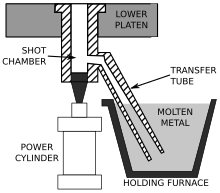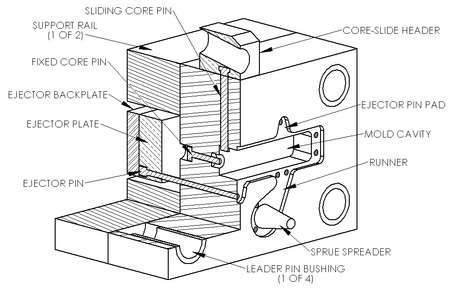The metal-stamping process is described in general, focusing on
types of stamping presses and tooling, as well as other equipment that
comprises a complete stamping-press line. The use of forming lubricants
and the process of part design is also discussed.
A stamping operation requires talented people and the right
equipment to perform successfully. How does the stamping process work,
and how are equipment and personnel employed to make sure quality parts
are stamped consistently?
A stamped sheetmetal part requires able creators backed by talented
personnel who allow their machinery—from stamping presses to
tooling--to reach its technological potential.
Designing a part
The birth of a stamped metal part is the designer’s drawing board,
perhaps the result of a request from a specifier. The designer must
plan a particular part while considering a multitude of factors. How is
the part expected to interact with other parts and best fit into a
component or assembly? Must the part be light in weight? What forces
must it withstand? How long must it last? What size should it be? What
is the environment, and how will material selection influence how the
part performs in that environment? What technology and machinery is
available in order to construct this part in an efficient and
cost-effective manner? Will the part be coated or must it be cleaned?
If so, how does that affect the choice of material and types of
lubrication required for manufacture?
Quality people and equipment required
Questions asked and answered, the proposed part enters the realm of
manufacturing. The effective metal-stamping operation, especially an
operation serving multiple clients with multiple requirements, boasts
an array of flexible equipment engineered and maintained to efficiently
produce a variety of parts. The employees overseeing and operating
shop-floor machinery must be well-trained to take advantage of the
technology.
Stamping presses serve specific needs
Obviously, stamping presses are the heart of any sheetmetal-stamping
operation. Presses come in varying tonnages, configurations and means
of operation. The majority of stamping presses can be classified as
mechanical or hydraulic. Mechanically driven presses typically boast
higher operating speeds—surpassing 2000 strokes/min. to produce parts
rapidly. Relatively simple 2D parts are ideally created in mechanical
presses, parts such as razor blades or electrical contacts.
Hydraulically powered presses traditionally offered force control
throughout the entire forming stroke, unlike traditional mechanical
presses that ramp up force as the press ram descends on the work
material. Though typically slower than mechanical presses, hydraulic
presses, with this total force control, have been the machinery of
choice to produce deeper 3D parts with cup or sink recesses. Producing
parts with depth in a stamping press is referred to as drawing.
In recent years, these formerly cut-and-dried distinctions between
mechanical and hydraulic presses have blurred as new press and
press-control technologies enable each to assume characteristics of the
other. A newer development, servo-powered presses, which are
technically mechanical presses often referred to as servo presses,
utilize servo drives to bring benefits of hydraulic and mechanical
presses into a single machine.
Increasingly complex tooling
Of course, a stamping press would just be a machine that makes noise
were it not for the tooling inside. One-hit dies represent the simplest
form of tooling, where one press hit pounds out a complete part, or at
least a shape that travels to secondary machinery for completion or to
another one-hit die in another press. Progressive dies, containing
multiple stations, add features to a part with each press hit as the
base material travels along the die in a strip, knopwn as a carrier
strip. In this manner a part is progressively formed. Transfer dies can
be considered a combination of one-hit and progressive dies. Here, a
material blank—without a carrier strip--travels from die to die,
eventually forming a complete part. Many large drawn parts are produced
via transfer dies. Transfer dies require mechanisms to physically lift
a part from one die station and deposit it into the next. This is
accomplished through the use of a transfer press—essentially a
specialized mechanical press—or via a part-transfer system attached to
an existing press.
Over the years, owing to new technology and efforts to reduce costly
and time-consuming secondary operations that take place away from the
press, more and more work occurs in the tooling. The result: more
complicated and costly stamping dies. Given this fact, die design,
maintenance, protection and utilization are so important to the
metal-stamping process that a manufacturer will have on staff personnel
dedicated to tooling issues.
The high cost of hard tooling such as stamping dies, and the care
required to allow this tooling to produce part after part to rigid
specifications, demand attention to detail in this area. To protect
tooling, a die designer or metal stamper will incorporate various
controls and sensors into the process. Often, sensors will be embedded
into tooling to ensure presence, and correct orientation and shape of
the part material. Die components such as punches may be built with
and/or coated with special material. These tool coatings allow for
creation of higher-quality stampings while increasing tool life. Many
stamping operations, especially those tasked with performing multiple
jobs on a single press line, incorporate quick-die-change (QDC)
equipment. Such equipment—rolling bolsters, die carts, clamps,
etc.—allow rapid changeout of tooling from one job run to the next in
order to keep presses running.
Forming lubricants are key to part quality and equipment life
Proper lubrication within the tooling is essential to the protection
of dies and presses, and also to the production of quality parts.
Depending on the part material, type of part to be produced and type of
tooling employed, specific forming fluids are used. Various lubricant
formulations exhibit properties that best serve specific stamping
requirements. In some cases, material is coated with lubricant prior to
entering the press. In other cases, forming fluids are applied to the
part material and tooling during the stamping process.
Lubricant selection reaches beyond part, tooling and material
considerations. More and more, safety and regulatory concerns affect
selection. Lubricants may be required to be reclaimed or disposed of
safely, and must not pose a hazard to employees or the environment.
Stamping-lubricant and lube-system suppliers have, therefore, developed
fluid formulations and methods of delivery and reclamation to address
these concerns.
Functional stamping-press line has many components
Stamping a part involves more than a press, tooling and forming
fluids. A fully outfitted press line includes feed machinery that
delivers part material to the press. This includes equipment to
transport stage and deliver coiled material into the press, or other
equipment to feed a press individual material blanks. In multiple-press
lines, robots or other part-handling machinery transport part material
from press to press, then capture finished parts for placement in bins
or racks. Conveyors or other material-handling equipment also move
parts or collect and transport scrap.







